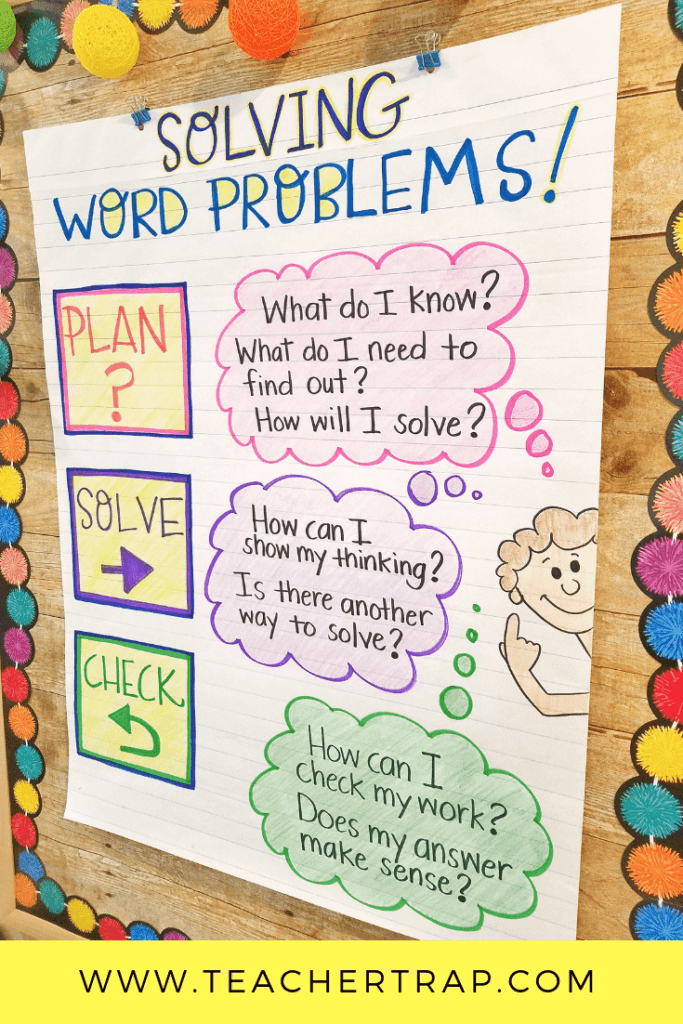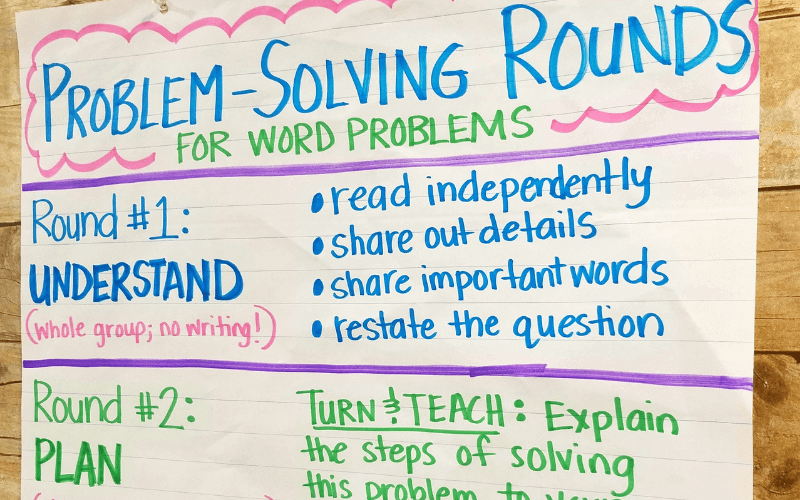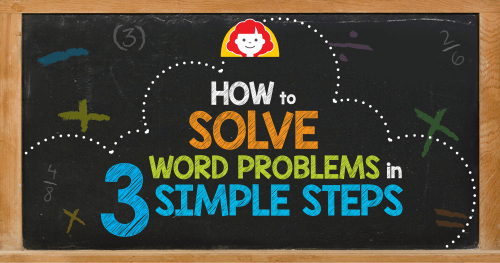
3-Step System
1. Read: Read the problem and decide what the question is asking.
- Read the problem 2 times or more.
- Underline or circle key words, phrases, and numbers. Draw a line through irrelevant information.
2. Plan: Think about what the story is asking you to do. What information are you given, and what do you need to find out?
- Draw a picture.
- Circle or underline key words. (Use highlighters or crayons to color-code key numbers and phrases.)
- Write out the question in your own words.
3. Solve: What strategy could you use to find the missing information: addition, subtraction, multiplication, or division?
- Write a number sentence and solve.
- Use counters.
- Create charts.
Check your work by explaining your reasoning. Does your answer make sense?
Download this free strategy checklist from Math Fundamentals to help your child solve word problems.
Different Strategies to Solve Word Problems
Everyone learns in a different way. What makes sense to one individual often isn’t the easiest option for another. Incorporating different strategies to solve word problems can help your child discover what strategy works best for him or her. A few tips to use are:
1. Circle numbers in a story and underline key phrases.
Color coding is a fun method to incorporate to help children decide what operation the question is asking for. Assign a color to each operation and highlight the phrase that identifies it. For example, red links to addition and blue links to subtraction.
2. Incorporate a key word list.
Key word lists are best used for teaching younger children how to solve word problems. As math curriculum advances, children should not be dependent on a key word list to solve a problem. The questions get trickier.
Addition
In all
Together
Total
Altogether
Combine
Sum
Join
Subtraction
Difference
Fewer
How many more
How much more
Left
Remain
Less
3. Visuals
If your child is a visual learner, drawing a picture or using counters can help him or her understand what the problem is asking. Use number lines, charts, or counters or draw a picture.
4. Write your own word problem.
Knowing what is needed to write a word problem is the first step in identifying key words to solve a story. Take turns writing your own word problems with your child and exchange them to solve.
5. Stay organized.
It is important to write clearly and keep work space neat so children can read and follow their own computations. Many children need a separate piece of paper to allow them enough space to solve and understand their answer. Graphing paper is a great option to help students record neat work.
Download this free sample word problem from Math Fundamentals, grade 1.
How to solve a two-step word problem
In a two-step word problem children are being asking to solve two related equations. These can get tricky for children to understand when they transition from one-step to two-step problems. Help your child understand his or her relationships within two-step word problems with these strategies:
1. Circle important information.
Circle numbers and important phrases that ask questions. The number sentences needed to solve these equations are hidden in those asking questions. Identify the first and second questions needed to solve.
2. Distinguish the two parts of the problem.
First identify the first step of the first part of the word problem. Write a number sentence and solve.
3. Use the answer from the first-step solution to the whole problem.
Use the answer from the first question to help you solve the next equation. What operation does the second question require?
Check your work by explaining your reasoning. What was the question answered? Is the answer reasonable for the question being asked?
Download this free sample two-strategy word problem from Math Fundamentals, grade 2
Download this free sample multi-strategy word problem from Math Fundamentals, grade 4
Evan-Moor’s Math Fundamentals is a great resource for training students how to solve word problems in 3 simple steps. It provides step-by-step directions for solving questions and guides children with helpful visuals and key phrases.
Check out Daily Word Problems for consistent practice solving word problems.
For more fun math tips and strategies check out our Math- Ideas, Activities and Lessons Pinterest Board.
Save these tips and Pin It now!

Word problems are a special kind of math challenge. Not only do they require computation skills, but they also test students’ reading comprehension and problem-solving abilities. This can be the perfect storm of frustration for many kids. But it doesn’t have to be so hard! Today, I’m sharing easy strategies for helping students master the word problem!
Start With Reading Comprehension
The first step in conquering word problems goes right back to good ol’ reading comprehension. Kids have a bad habit of reading word problems like they are just passing through words to get to the numbers. Blah, blah, blah. 127! Blah, blah, blah, 52! They search for numbers and then rush to DO something with those numbers.
If our students are going to find success with word problems, they need to use their good reading strategies! Teach your students to:
Reread: Slow down and reread as many times as needed
Visualize: Imagine what is taking place in the problem. What is the order of events?
Ask questions: What do I know? What do I need to find out?
Make predictions: What would be a reasonable result? Do I expect the answer to be more or less than the numbers I’m given?
Teach a Problem-Solving Routine
Help students form effective thinking habits by teaching and practicing a problem-solving process. I’m not talking about a rote set of steps like CUBES (Circle the numbers, Underline the question, Box key words, etc.). I’m talking about a THINKING routine that helps the child learn the critical thinking skills involved in solving real problems.
I’ve found a simple PLAN, SOLVE, CHECK format works best. With young children, the biggest issue I find is that they simply skip (or struggle with) one of these steps, which causes a breakdown in their ability to solve the problem. In fact, I form my guided math groups for word problems around those three categories (planning strategies, solving strategies, checking strategies.) **You can grab a FREE Word Problem Thinking Mat in the Preview File of my Tiered Word Problems Pack.
Compare Problem Structures
One of my favorite word problem teaching tools is something I call “Side-by-Sides.” This is simply where we solve two different problems and then compare the structure of the problem and the operation used.
When students model, solve, and discuss the different problem types, they grow a deeper understanding of how word problems work.
**You can grab FREE samples of side-by-side problems in the Preview File of my Side-by-Side Word Problems Pack or grab a FREE Side-by-Side Mat in the Preview File of my Tiered Word Problems Pack for 2nd Grade or 3rd Grade.
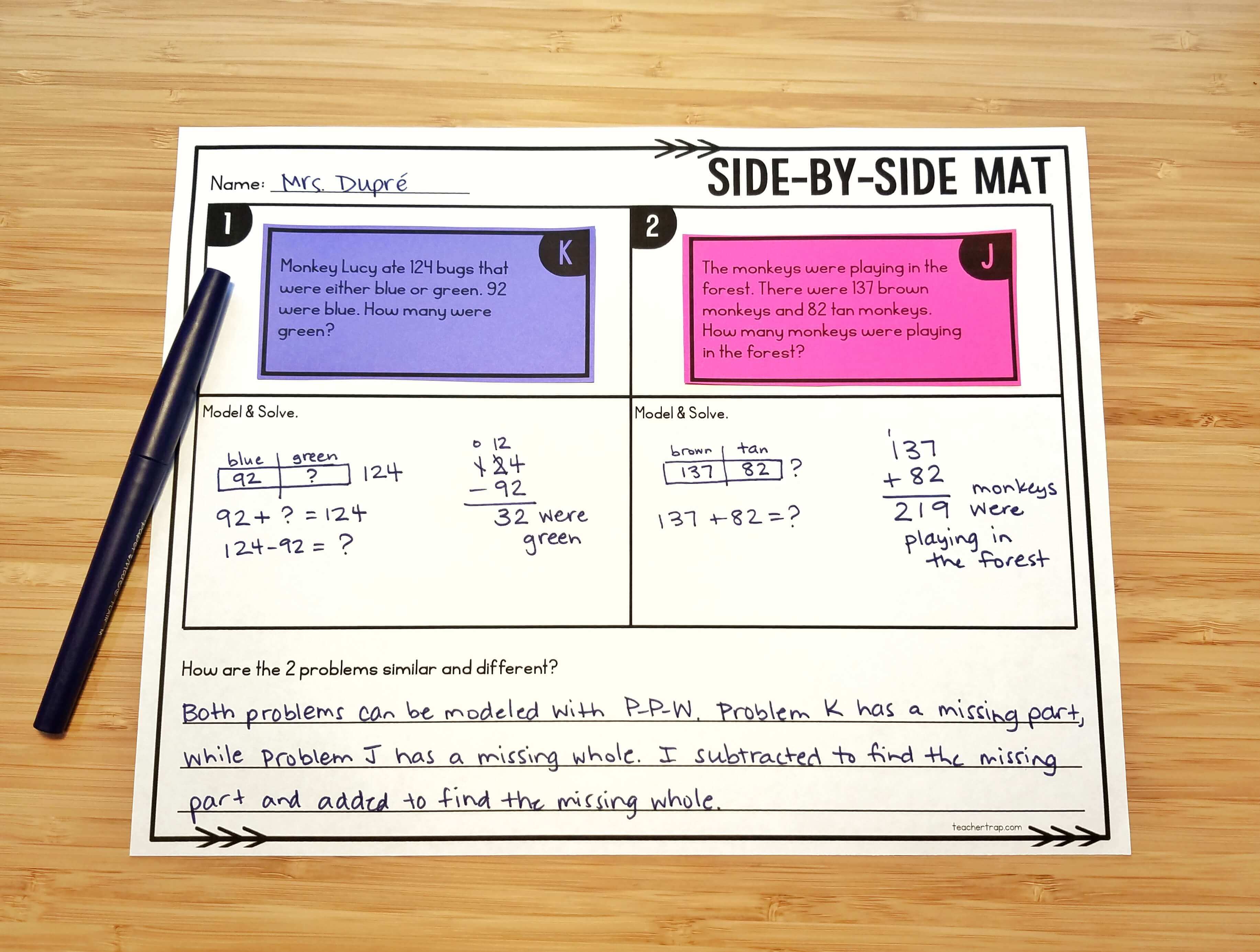
Start With the Easy Version
Differentiation isn’t just for reading! Many students get overwhelmed when they see large numbers in word problems, so why not meet them where they are? I use what I call “Tiered Word Problems” to help students understand word problem structures and grow confidence before tackling the on-level version.
In my Word Problem Solving Bundle, I provide all kinds of leveled word problems – Tiered Problem Pages, Task Cards, Exit Tickets, and more, that all increase in challenge from first through fifth grade. This allows me to scaffold instruction by student need, and throughout the school year.
**You can grab free goodies and sample pages from the Bundle in the Word Problem Solving Bundle Sampler Pack.
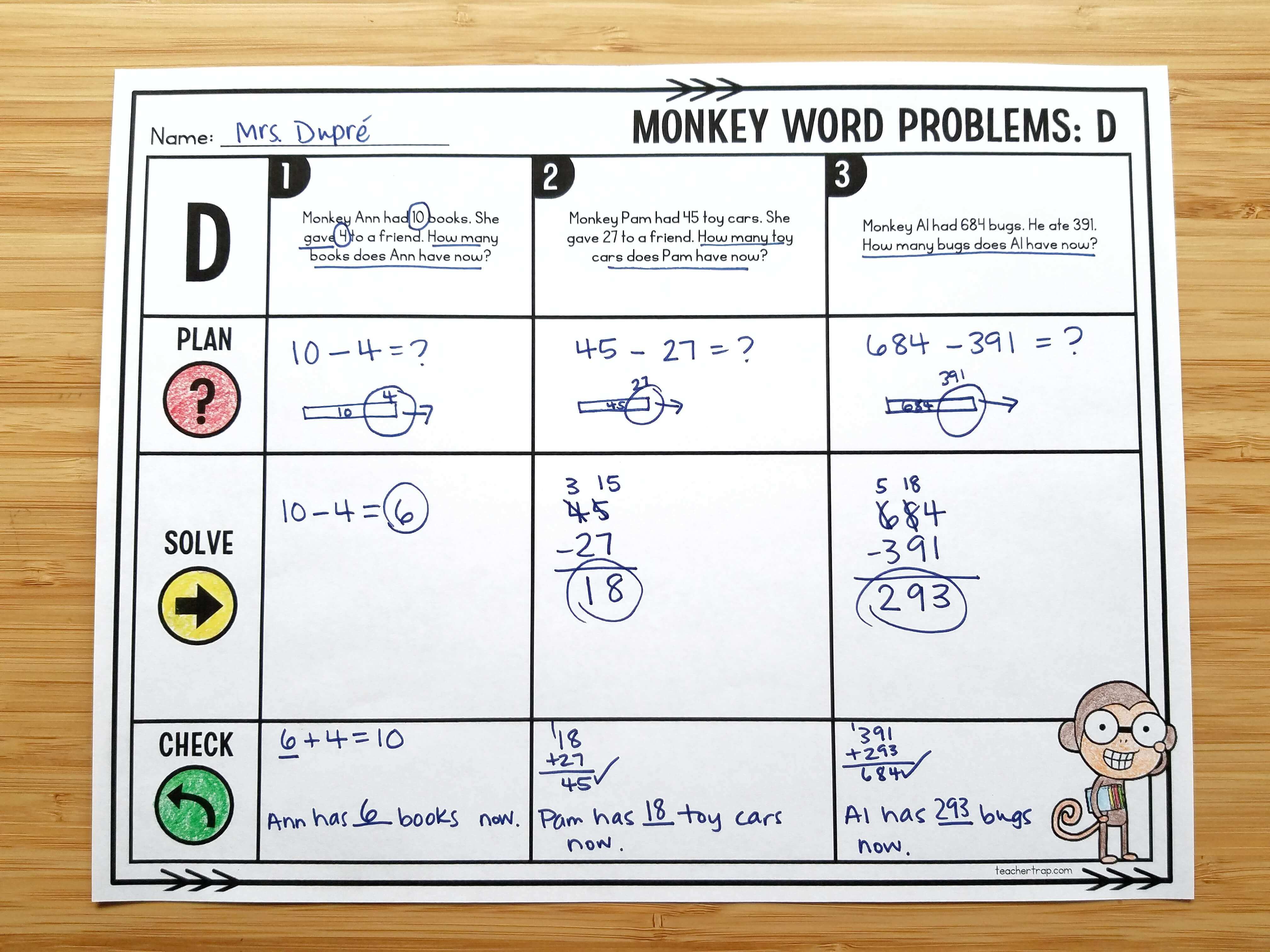
Use Problem-Solving Rounds
Problem-Solving Rounds changed math instruction in my classroom forever! This powerful routine encourages students to move through the problem-solving process I mentioned at the beginning of this post, to explain their thinking, and to reflect on other possible strategies and solutions.
Since using Problem-Solving Rounds, my students are more confident with word problems, have a deeper understanding of problem-types, and are better able to tackle new and challenging tasks.
The basic structure of the rounds follows the Problem-Solving Process I’ve shared. In Round 1, students read and discuss the problem with a focus on UNDERSTANDING. In Round 2, they turn to a partner and explain how they PLAN to solve the problem. They SOLVE the problem independently in Round 3, and in Round 4 they work with a partner and as a whole class to CHECK and reflect on their work. For a detailed guide to this process, check out my blog post all about Problem-Solving Rounds.
I’d love to hear from you! Comment below with your favorite word problem tips for teachers!
Word problems are a great way to prepare your students for using math in real life. However, many students find them intimidating.[1]
First, introduce word problems so that your students will understand why they’re used. Next, explain how to use the CUBES approach to solving word problems. You can then model the process for your students and have them practice it on their own.
-
1
Explain the purpose of word problems. Without proper context, some students may view word problems as unnecessarily complicated. However, they’re actually intended to help students use math to solve real world problems, such as building a fence, buying enough food for a party, or adjusting a recipe. The math is still the same, but the way the problem is presented is more relevant to real life.[2]
- Ask students to work with a partner or group to identify ways that they might use math in real life. Next, have them turn that situation into a math-based story.
- For example, they might say they use math when dividing into teams at recess. They could turn that into a story like this: “If the class has 20 students and we need 2 teams to play, how many students will be on each team?”
-
2
Help students create a word problem that fits their life.[3]
Have them follow the process above to create a math story-problem specific to their own life. This helps the lesson feel relevant to students, which gets them engaged. It also helps them reach higher levels of learning.[4]
- Suggest that they incorporate a hobby or favorite interest. For example, they might write a problem that has to do with a sport they play or a problem that centers around a favorite animal.
- Have them put their name in the problem.
- Here’s an example: “If Alex wants to score 10 soccer goals over the second half of the season and there are 5 more games left to play, how many goals should Alex score per game to stay on track?”
-
3
Take out the numbers to help students focus on the question. Students need to know what the problem is asking if they’re going to solve it, but recognizing the question is hard. It’s easy to get hung up on the numbers! Rewrite a basic word problem without the numbers, then ask students to determine what it’s asking.[5]
- You may need to do this several times for students to understand.
- Your sample problem might look like this: “Sarah is buying pizza for her slumber party. If each pizza has a certain number of slices and she knows how many guests are coming, how can she estimate the number of pizzas she needs. What other information might she need to arrive at the answer?” Your students should point out that Sarah would need to know how many pieces of pizza her guests will eat on average. She could then multiple that number of slices by the number of guests. To get the number of pizzas, she’d then divide the total number of slices by the number of slices in a pizza.
-
4
Tell students to illustrate word problems. When students are first working with word problems, illustrating them can help better understand the context. They can draw the action of the problem, the items depicted in the problem, or whatever helps them.[6]
- For example, when determining how many pizzas Sarah will need to buy for her slumber party, the students could draw circles to represent the pizzas and stick figures to represent Sarah and her guests.
- However, stress that this is not a requirement for arriving at your answer, as some students may find this extra step frustrating.
- This can help visual learners better understand word problems.
-
5
Make sure the word problems match students’ language and math skills. Students must be able to understand what the problem is saying in order to know what it’s asking. Similarly, they won’t be able to arrive at the answer unless they know how to do the required math processes.
- For example, students who can only add numbers should be given word problems that only require addition.
-
1
Summarize the CUBES process for students. CUBES provides students with an easy-to-follow process for solving word problems that includes all of the relevant steps. It’s also easy for students to remember, as it offers a fun, math-related acronym. Here is what each letter stands for:[7]
- C-Circle the numbers.
- U-Underline the question.
- B-Box the keywords.
- E-Eliminate unnecessary information.
- S-Show your work.
-
2
Tell students to circle all of the numbers, including those in word form. It’s common for word problems to include numbers in word form, even if some numbers are written numerically. Circling them can make it easier for students to come back to them once they start to work through their solution.[8]
- Although some numbers may be extraneous information, it’s important that students circle all of them during this step. They can eliminate unnecessary information later.
- For example, your problem might look like this: “Katie asked 7 friends to sleepover on Friday, but only 4 can make it. She knows that she and each friend will eat 6 chicken nuggets, and each bag of frozen nuggets contains 15 nuggets. How many bags will she need to make sure she has enough nuggets?” Students should circle the 7, 4, 6, and 15.
-
3
Underline the question within the problem. The question is what the problem is asking the student to do. It’s what they should know once they’ve finished working the problem.[9]
- For example, they might need to know how much of something they’d need or how much of something they’d have left.
- When students are first learning word problems, the question should be at the end of the problem. It will often have a question mark at the end.
- In the problem above, the question is this: «How many bags will she need to make sure she has enough nuggets?”
-
4
Draw boxes around any keywords, such as “total” or “all together.” Keywords signal to the student what they’re expected to do to solve the problem, such as add, subtract, multiply, or divide.[10]
In some cases, synonyms of these words will be used. Students need to know how to identify these keywords, then they can box them in so that they won’t forget to use them.[11]
- For example, addition could be indicated by words like “in total” or “all together.” Similarly, subtraction should be signified by “difference” or “less.”
- In the problem above, students would draw boxes around «only,» which will indicate subtracting. They’ll also draw boxes around «how many» and «enough,» which suggest that they’ll need to first multiply and then divide.
-
5
Show students how to eliminate unnecessary information. Many word problems have unnecessary information that complicates the process. For example, the problem might contain unnecessary numbers or extra information. Students can avoid confusion by crossing out this information before they start working on a solution.[12]
- For example, the sample problem has extra numbers: “Katie asked 7 friends to sleepover on Friday, but only 4 can make it. She knows that she and each friend will eat 6 chicken nuggets, and each bag of frozen nuggets contains 15 nuggets. How many bags will she need to make sure she has enough nuggets?” The students could cross out the 7, since it isn’t necessary for arriving at the correct answer.
-
6
Ask students to show their work. Not only will this ensure they receive full credit, it also helps students check their work. If they get the wrong answer, they can identify where they made errors and correct it moving forward.[13]
- Here’s how we would solve Katie’s slumber party question:
- 4 friends are coming, plus Katie: 4 + 1 = 5 girls
- Each of them will eat 6 nuggets: 5 x 6 = 30 nuggets
- Each bag has 15 nuggets: 30 / 15 = 2 bags needed
- Answer: Katie needs to buy 2 bags of nuggets.
- Here’s how we would solve Katie’s slumber party question:
-
1
Allow students to follow along as you solve word problems. Provide them with a worksheet with the problems printed on it. Then, show them what they need to do, asking them to copy down what you write onto their paper. Go slowly, taking questions as they arise.[14]
- You will need to work through several problems until your students start to grasp the concepts. Make sure the problems you choose match your students’ language and math skills.
- You can work through the problems on the board or using a projector.
- For example, you could solve this problem: «Diego is baking cookies for his team’s bake sale. Last year, he earned $100 to help his team. This year, he wants his sales to reach $120. If each cookie will cost $0.75, how many cookies will Diego need to bake?»
-
2
Talk through your strategy as you solve the problem. Explain each step in detail so that students can understand your thought processes as you approach the problem.[15]
In addition to seeing what you write, they can get an idea of how you arrived there.[16]
- Say, «I’m going to start by circling the numbers.» Circle 100, 120, and 0.75.
- Next, say, «“Now I’m going to underline this, since I know it’s the question.” You’d underline this statement: «If each cookie will cost $0.75, how many cookies will Diego need to bake?»
- Say, “Now I’m going to cross this out, since the problem isn’t asking me about this.» You’d cross out the sentence about Diego earning $100 last year.
-
3
Show your work. This is essential for students to understand how to do it themselves. Don’t do any of the math in your head, even if it’s something really simple. Remember, your students should be copying down everything you write so that they can refer to it in the future.[17]
- Write the steps in order to make it easier for students to copy down.
- Here’s how to work out Diego’s problem:
- Diego needs to make $120 by selling cookies for $0.75: 120 / .75 = 160
- Answer: He will need to bake 160 cookies.
-
4
Point out parts of the problem that could have tripped you up. After you arrive at your answer, help students see where you could have made errors. For example, you might have included unnecessary numbers, or you may have gotten tripped up over extra information.[18]
- Not only does this show students what to watch out for, it also shows them that mistakes can happen to anyone.
- For example, you might have accidentally used the information about Diego earning $100 last year, which isn’t relevant to the question.
-
5
Call on students to identify the next step once they catch on. This gets students to start thinking the process through on their own. At first, pause and ask students to reflect on what they need to do next. Then, call on a student. Ask a different student to supply the next step.[19]
- If a student gets the answer wrong, praise the effort, then ask another student to help. Say, “Great enthusiasm, James! We’re almost to that step, but we need to do something else first. Amy, could you help us out?”
-
1
Allow students to work in groups or pairs while they learn the process. Give the students a few practice problems to solve together. This provides built-in supports for struggling students and helps students solidify their knowledge as they explain their reasoning to their classmates. Move about the room to ensure that they are on track.[20]
- Remind them to use CUBES to solve their problems.
- You can make sure students are on track by listening to what they are saying. Are they correctly explaining the process? Do they appear to be confused? Use your judgement to determine if you need to offer guidance.
- Praise groups that are on track. Say, «Excellent work!» or «I’m proud of the progress you’re making!»
-
2
Ask students to write their own problems, then switch papers. This is a fun way to deepen your students’ understanding of word problems. Students can develop real word story questions that relate to their lives, then they can have fun solving their friends’ stories.[21]
- It’s a good idea to have them do this in groups, as it increases the quality of the questions. Also, it’ll allow you to check each group’s questions before they switch papers, which would be harder if each student created questions.
- Not only is this fun for students, but it encourages higher-level learning.
-
3
Provide students with practice problems to solve individually. Students will be ready for individual practice after they’ve watched you model the process and have worked in groups or pairs. At this point, you can work with individual students who are having difficulty grasping the concept. Help them work through the CUBES process one-on-one until they start to grasp it.
- You can make up your own worksheets, or you can download them for free online.[22]
Make sure that the word problems you give them match their language and math skills. - When making your own worksheets, it’s best to work through the problems before you give them to students to make sure all of the information is present. Also, stick to topics your students will understand, such as sports, pets, and food.
- If a student seems to be struggling, you may want to invite them to tutoring.[23]
- You can make up your own worksheets, or you can download them for free online.[22]
Sample Word Problems and Illustrated CUBES Process
Add New Question
-
Question
How can I help my children solve word problems?
Daron Cam is an Academic Tutor and the Founder of Bay Area Tutors, Inc., a San Francisco Bay Area-based tutoring service that provides tutoring in mathematics, science, and overall academic confidence building. Daron has over eight years of teaching math in classrooms and over nine years of one-on-one tutoring experience. He teaches all levels of math including calculus, pre-algebra, algebra I, geometry, and SAT/ACT math prep. Daron holds a BA from the University of California, Berkeley and a math teaching credential from St. Mary’s College.
Academic Tutor
Expert Answer
Have them look for keywords within the problem that help you figure out the steps you need to take.
-
Question
What does keywords mean in math?
Daron Cam is an Academic Tutor and the Founder of Bay Area Tutors, Inc., a San Francisco Bay Area-based tutoring service that provides tutoring in mathematics, science, and overall academic confidence building. Daron has over eight years of teaching math in classrooms and over nine years of one-on-one tutoring experience. He teaches all levels of math including calculus, pre-algebra, algebra I, geometry, and SAT/ACT math prep. Daron holds a BA from the University of California, Berkeley and a math teaching credential from St. Mary’s College.
Academic Tutor
Expert Answer
Keywords tell you what you need to do to solve a word problem. For instance, «total» and «all together» mean you need to add. «Difference» and «less» mean you need to subtract.
Ask a Question
200 characters left
Include your email address to get a message when this question is answered.
Submit
-
Word problems are difficult for many learners, so have patience.
-
Encourage students to keep trying, even if they don’t get it at first.
-
You can find several different acronyms for solving word problems, but CUBES incorporates all of the steps.
-
Make sure that the practice problems you choose don’t include mathematical concepts that are beyond your students. When in doubt, work through the problem yourself before giving it to your young learners.
References
About this article
Thanks to all authors for creating a page that has been read 8,920 times.
Did this article help you?
Solving Word Problems in Mathematics
What Is a Word Problem? (And How to Solve It!)
Learn what word problems are and how to solve them in 7 easy steps.
Real life math problems don’t usually look as simple as 3 + 5 = ?. Instead, things are a bit more complex. To show this, sometimes, math curriculum creators use word problems to help students see what happens in the real world. Word problems often show math happening in a more natural way in real life circumstances.
As a teacher, you can share some tips with your students to show that in everyday life they actually solve such problems all the time, and it’s not as scary as it may seem.
As you know, word problems can involve just about any operation: from addition to subtraction and division, or even multiple operations simultaneously.
If you’re a teacher, you may sometimes wonder how to teach students to solve word problems. It may be helpful to introduce some basic steps of working through a word problem in order to guide students’ experience. So, what steps do students need for solving a word problem in math?
Steps of Solving a Word Problem
To work through any word problem, students should do the following:
1. Read the problem: first, students should read through the problem once.
2. Highlight facts: then, students should read through the problem again and highlight or underline important facts such as numbers or words that indicate an operation.
3. Visualize the problem: drawing a picture or creating a diagram can be helpful.
Students can start visualizing simple or more complex problems by creating relevant images, from concrete (like drawings of putting away cookies from a jar) to more abstract (like tape diagrams). It can also help students clarify the operations they need to carry out. (next step!)
4. Determine the operation(s): next, students should determine the operation or operations they need to perform. Is it addition, subtraction, multiplication, division? What needs to be done?
Drawing the picture can be a big help in figuring this out. However, they can also look for the clues in the words such as:
– Addition: add, more, total, altogether, and, plus, combine, in all;
– Subtraction: fewer, than, take away, subtract, left, difference;
– Multiplication: times, twice, triple, in all, total, groups;
– Division: each, equal pieces, split, share, per, out of, average.
These key words may be very helpful when learning how to determine the operation students need to perform, but we should still pay attention to the fact that in the end it all depends on the context of the wording. The same word can have different meanings in different word problems.
Another way to determine the operation is to search for certain situations, Jennifer Findley suggests. She has a great resource that lists various situations you might find in the most common word problems and the explanation of which operation applies to each situation.
5. Make a math sentence: next, students should try to translate the word problem and drawings into a math or number sentence. This means students might write a sentence such as 3 + 8 =.
Here they should learn to identify the steps they need to perform first to solve the problem, whether it’s a simple or a complex sentence.
6. Solve the problem: then, students can solve the number sentence and determine the solution. For example, 3 + 8 = 11.
7. Check the answer: finally, students should check their work to make sure that the answer is correct.
These 7 steps will help students get closer to mastering the skill of solving word problems. Of course, they still need plenty of practice. So, make sure to create enough opportunities for that!
At Happy Numbers, we gradually include word problems throughout the curriculum to ensure math flexibility and application of skills. Check out how easy it is to learn how to solve word problems with our visual exercises!
Word problems can be introduced in Kindergarten and be used through all grades as an important part of an educational process connecting mathematics to real life experience.
Happy Numbers introduces young students to the first math symbols by first building conceptual understanding of the operation through simple yet engaging visuals and key words. Once they understand the connection between these keywords and the actions they represent, they begin to substitute them with math symbols and translate word problems into number sentences. In this way, students gradually advance to the more abstract representations of these concepts.
For example, during the first steps, simple wording and animation help students realize what action the problem represents and find the connection between these actions and key words like “take away” and “left” that may signal them.
From the beginning, visualization helps the youngest students to understand the concepts of addition, subtraction, and even more complex operations. Even if they don’t draw the representations by themselves yet, students learn the connection between operations they need to perform in the problem and the real-world process this problem describes.
Next, students organize data from the word problem and pictures into a number sentence. To diversify the activity, you can ask students to match a word problem with the number sentence it represents.
Solving measurement problems is also a good way of mastering practical math skills. This is an example where students can see that math problems are closely related to real-world situations. Happy Numbers applies this by introducing more complicated forms of word problems as we help students advance to the next skill. By solving measurement word problems, students upgrade their vocabulary, learning such new terms as “difference” and “sum,” and continue mastering the connection between math operations and their word problem representations.
Later, students move to the next step, in which they learn how to create drawings and diagrams by themselves. They start by distributing light bulbs equally into boxes, which helps them to understand basic properties of division and multiplication. Eventually, with the help of Dino, they master tape diagrams!
To see the full exercise, follow this link.
The importance of working with diagrams and models becomes even more apparent when students move to more complex word problems. Pictorial representations help students master conceptual understanding by representing a challenging multi-step word problem in a visually simple and logical form. The ability to interact with a model helps students better understand logical patterns and motivates them to complete the task.
Having mentioned complex word problems, we have to show some of the examples that Happy Numbers uses in its curriculum. As the last step of mastering word problems, it is not the least important part of the journey. It’s crucial for students to learn how to solve the most challenging math problems without being intimidated by them. This only happens when their logical and algorithmic thinking skills are mastered perfectly, so they easily start talking in “math” language.
These are the common steps that may help students overcome initial feelings of anxiety and fear of difficulty of the task they are given. Together with a teacher, they can master these foundational skills and build their confidence toward solving word problems. And Happy Numbers can facilitate this growth, providing varieties of engaging exercises and challenging word problems!






